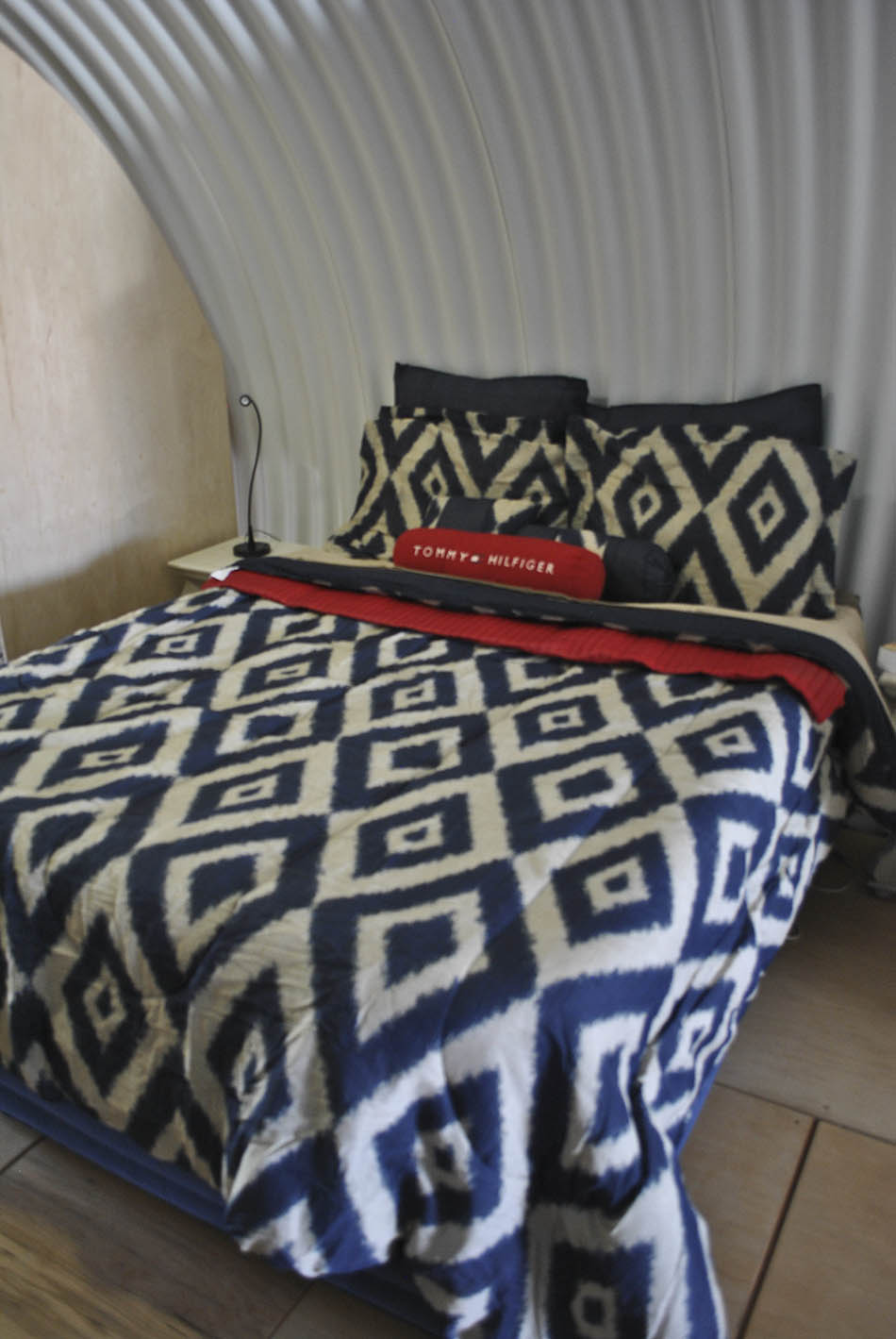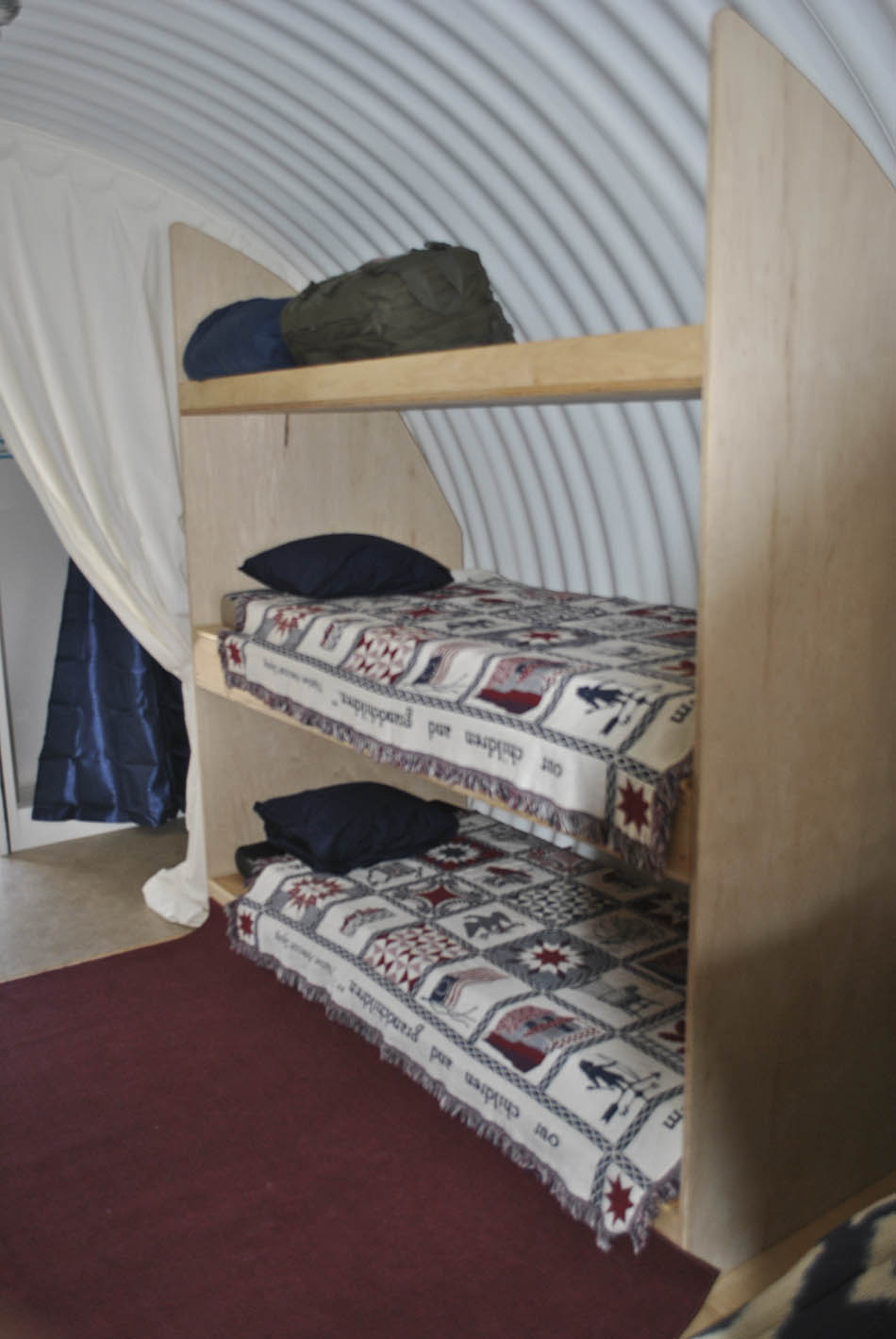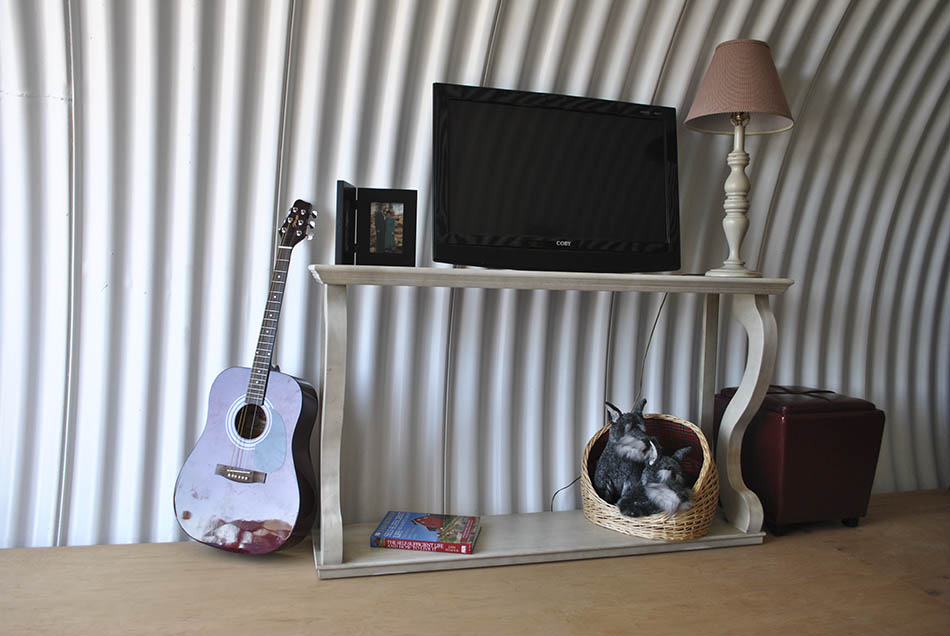Underground Bunkers
Because the Survival of your loved ones is your highest priority
Underground Bunkers come in many different styles and designs. Underground Shelters USA builds and designs both steel and concrete bunkers. During your search, you may also find bunkers made from storage containers, concrete, fiberglass and even dirt and wood. Choose carefully, as your life may depend upon your choice.

Important Shelter Design Requirements for Underground Bunkers:
Before purchasing an underground bunker, do a careful 'risk assessment' for your location and design your bunker accordingly. Your assessment of the risk, however, may change due to unforeseen circumstances. We would suggest that you choose a bunker design that covers a full array of hazards. We call this type of bunker an 'All Hazard Shelter'.
'All Hazard Shelters', must withstand violent earth movement from severe earthquakes; high velocity winds from tornados and hurricanes; invasion from mobs; heavy overpressures from nuclear blast; all types of radiation; EMP, wild fires; and air contamination from fallout and chemical and biological war gasses. It is interesting to note that underground shelters designed for nuclear survival satisfy the entire scope of requirements for 'All Hazard Shelters™', and the cost of purchasing this type of shelter is a small percentage more than purchasing a shelter that is limited in its capabilities.
If you choose to purchase an 'All Hazard Shelter', ask the provider if the shelter design meets the following criteria.
Utah Shelter Systems can proudly claim an affirmative answer to all of the above requirements.
Underground Steel Shelters
Utah Shelter Systems specializes in manufacturing underground steel shelters because they offer very cost effective protection from the effects of nuclear weapons, as well as biological and chemical weapons (NBC). That ordinary citizens can be so effectively protected to within 1/2 mile of a large yield nuclear explosion for about the cost of a new pickup truck is remarkable. The concept is simple. A steel cylinder of a usable size is outfitted with bulkheads, a deck, electrical system, ventilation system, and properly designed entrances, and buried to a suitable depth to ensure proper earth arching and shielding. If the wall thickness of the cylinder is thick enough, and the backfill is performed to industry specifications, such a structure will endure a nuclear shock that would destroy all above ground buildings within a 5-mile radius of the blast.
Steel Shelter Design Features
The overall design of our underground steel shelter provides protection from blast, earth movement, fire, radiation, EMP and chemical and biological war gasses. This is accomplished through careful engineering and design of the shelter body, doors, air filtration systems; and the geometry of the entrances and the installation process.
Shelter Body
Corrugated steel pipe (CSP) shelters were tested and proven at the Nevada test site to blast pressures of 200 psi. In order to achieve protection to that level, the shelter must have an arched ceiling and the dirt cover over the shelter chamber must be equal to or greater than the diameter of the shelter. At this depth, 'earth arching' is achieved. Care must be taken to properly match the gauge of the steel to the shelter diameter. Eight-foot shelters are built of the proper gauge to be placed into a 16-foot hole and to safely withstand the burden of 8 feet of dirt cover plus the additional overpressure of 200 pounds per square inch of air blast. Nine-foot shelters will reach this level of protection in an 18-foot hole. Ten-foot shelters are designed to be placed into a 20-foot hole with 10 feet of cover. Flat roofed steel shelters will not withstand these heavy over burdens because they cannot achieve "earth arching". They will fail catastrophically under these overpressure loads.
The thermal pulse from a nuclear weapon will not penetrate through the dirt cover, into the interior of the shelter. The pulse, however, can oblate steel from the outside door, if the shelter is near the area of detonation. When shelters are located near nuclear targets, a sacrificial cover is provided for placement over the steel hatch door.
Radiation: Protection from gamma radiation can be achieved with as little as 4 feet of dirt cover or 3 feet of concrete cover. Every 4 inches of dirt (and 3 inches of concrete) gives a halving thickness, or protection factor (PF) of 2. Ten halving thickness is required to diminish (attenuate) medium to high levels of radiation to an acceptable level.
Six to 8 feet of dirt cover is required to attenuate initial radiation to acceptable levels. Initial radiation occurs within the first minute of the blast and within a 1-½ mile radius of ground zero. Blast damage is also an issue at that range. All Utah Shelter Systems shelters are designed to withstand gamma and initial radiation, as well as high blasts in the initial radiation zone.
Entrances
The greatest risk for radiation accumulation is through the entrances. Steel doors are not thick enough to attenuate gamma radiation to acceptable levels. Utah Shelter Systems has designed the entrances to attenuate gamma by providing a 90-degree turn, and long vertical and horizontal runs. Larger diameter entrances require longer horizontal runs. We can customize your entrances to your desired diameter. If the shelter is near a nuclear blast target and there is a threat of initial radiation, six feet of shielding must be placed into the horizontal run to protect the interior of the shelter. We also have a special 'T' shaped entrance, if desired, to provide storage space for the shielding material. Shelters this close to targets should have entrances no greater than 4' in diameter.

For further information on Radiation, see Weapons Effects.
All of our shelters have two entrances to assure egress in the event one entrance is blocked by debris. All entrances are protected with steel hatch type blast doors, or concrete filled vertical doors.
Distance and geometry play an extremely important role in the attenuation of radiation. It is mandatory that nuclear shelter entrances have both a vertical and horizontal component, connected with a 90-degree turn. To properly attenuate gamma radiation, the total entrance length must be at least 4 times the diameter, with the vertical and horizontal legs as close to the same size as possible.
Gamma radiation is a factor during the first two weeks after a nuclear event. Gamma radiation is directional and will not 'corner' well. The 90-degree turn between the vertical and horizontal run will attenuate 90% of the gamma radiation and the horizontal run will reduce the remaining radiation to a small fraction. Large diameter entrances require long runs and are not practical in the attenuation of initial radiation.
Initial radiation is more penetrating than gamma radiation. It is a factor during the first minutes of the explosion, and affects all the area within 1-1/2 miles of the blast. People sheltering within that area will have lethal levels of initial radiation if they do not properly shield against this effect. The vertical and horizontal runs should each be between 10 and 12 feet long, and the diameter of the entrance should not exceed 48". Initial radiation is not significantly attenuated by 90- degree turns. The horizontal run of the entrance, therefore, should be filled with shielding materials after the occupants have entered the shelter. Water, rice or any other material containing large amounts of hydrogen make good shields against initial radiation. These principles must not be compromised! Larger diameter entrances are comfortable and convenient, but the occupants may not survive if they are within the 1-1/2 mile zone of detonation.

Entrances may be put into buildings such as the home, garage or outbuildings. However, to protect against debris or fire, always place one entrance into the yard, exterior to the building. Entrances may be placed on either the ends or the sides of the shelter. Side entrances free the interior flat ends for furniture or bathroom use. However, when figuring transport costs, a side entrance increases the overall width and will possibly increase the transport cost.
EMP Protection
Protection from EMP is accomplished by completely surrounding sensitive electrical equipment with metal. This metal encasement is called a 'Faraday Cage'. Steel shelters form a natural faraday cage. Our hatch doors have special metal paint and gaskets that create metal to metal contact with our bunker entrances. If commercial power, antennas, or other electrical wires are brought into the bunker, we design wave guides, filters and delta Y transformers into the system. In our own personal shelters, we double protect all critical radios and other vulnerable equipment in an interior faraday cage to assure their survival. A simple, inexpensive faraday cage can be constructed from a steel garbage can. Wrap your equipment in soft towels or place them in cardboard boxes before placing them into the cage. Do not ground the can to the bunker hull.
For further information on EMP, see Weapons Effects.
ANDAIR Ventilation Systems
All of our shelters are fitted with the Swiss made ANDAIR ventilation systems. These motorized systems can be run manually or by electricity and come complete with a prefilter, high effeciency filters (both HEPA and Charcoal), hose, metering device (controls the amount and velocity of air coming into the filter), and two blast valves. It is designed to force a positive pressure into the shelter, so that contaminated air cannot intrude to the inside through tiny leaks in the structure. These filters have been tested against all known war gasses.
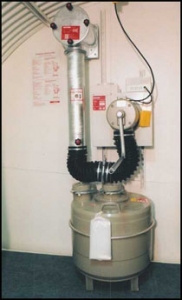
Concrete Shelters
Utah Shelter Systems has an experienced and highly qualified team, consisting of a nuclear engineer, civil engineer, architect and EMP specialist, ready to design and build concrete shelters to the Swiss standard. We can customize to your needs; but we also have pre-designed plans for your convenience (see concrete plans). Our nuclear engineer has trained extensively in Switzerland and the team receives continual guidance and direction from Swiss engineers at ANDAIR, in Andelfingen Switzerland.
Concrete shelters are comfortable and can be designed to accommodate large numbers of people. The Swiss, almost exclusively, build concrete shelters that are placed in deep underground basements of homes, hospitals, schools, hospitals, public buildings, hotels, and most all other buildings. The entire population of Switzerland can reach a shelter in a matter of minutes. These concrete shelters are built to last for hundreds of years.
Homes and buildings in Switzerland are built to the same standard; therefore, the shelters do not need to be re-built. On the other hand, the expected life of steel shelters is only 100 years. However, the average life expectancy of homes and buildings in America (because they become outdated) is approximately 70 years. It would not be cost-effective for the United States to mandate a national concrete shelter program under our homes and buildings.
Swiss shelters for private homes must are built to a minimum code of 1 atmosphere (15 psi), and government civil defense shelters are built to a 45-psi code. Military and critical mission personnel in Switzerland are assigned to heavy blast shelters in the 200-psi plus level. Please take note that our 'All Hazard' steel shelters, if installed correctly, also protect to the 200-psi level. We believe these Swiss codes should set the standard for shelters in the United States.
Governments that mandate a national shelter program can afford the luxury of building large population concrete shelters. They build in mass and tax their citizens accordingly. They build and install these shelters to last for long periods of time. When people move and purchase another home, they can be assured that the shelter in the new home will be built to the same standard and code as the shelter they have left.
Shelters constructed of reinforced concrete are very effective; but, when built even to the minimum Swiss code, these concrete shelters cost four to five times more than the same size steel shelters. Steel shelters, by virtue of the small diameter, angled entrances and the deep burial depth, achieve a much higher level of protection than is found in the Swiss public shelter systems.
Many people in America mistakenly believe that shelter ceilings and wall slabs of an 8-inch thickness will protect them from the effects of radiation and blast. They have been misinformed. Eight inches of concrete, with no building overhead, will give a radiation PF of less than 8. Even in low radiation risk areas, this level of protection is not adequate to save lives. The accumulated dose for one week would reach between 300 rads and 600 rads, with an expected probable death rate between 50% and 100%.
The minimum blast and radiation requirement, with no building overhead, is 22 inches (see chart below). Shelters built under a building, however, have an automatic PF of approximately 15, because of the mass of the home and roof above. An eight-inch slab roof under a building will give a PF of about 100. People in low to medium fallout risk areas will most probably survive with no symptoms. People in high fallout risk areas, however, will receive about 200 rads, with some deaths. They will also be expected to have an 11% increase in survivor cancer deaths later in their lives. This concrete level does not meet the 14-inch minimum blast and radiation requirements for shelter slabs under buildings.
The following are the minimum concrete thickness for Swiss standards of 15 and 45 psi.
The interior wall thickness is dependent on the window exposure in rooms exterior to the shelter. The specifics of this information are offered in the manual, 'Technical Directives for the Construction of Private Air Raid Shelters'. See ordering information.
Call Utah Shelter Systems for all your concrete shelter needs. We would be happy to give you an initial consultation, free of charge.
Types of Concrete Shelters:
It is next to impossible to retrofit a basement shelter into an existing basement and achieve the proper shielding and blast protection needed to meet minimum Swiss standards for 15 psi. The maximum blast protection achieved is usually well under 5 psi., as the shelter walls and ceiling must be self supporting and independent of the building in order to reach protection from those blast levels. Significant radiation protection factors, however, can be achieved, by placing enough mass overhead and around the shelter. Some areas of low blast may receive high levels of radiation from rain out, local winds, or fast moving prevailing winds. To reach a minimum PF of 100, place at least 14 inches of concrete (or 18 inches of dirt) overhead. The walls receive radiation from windows and door openings. They must, therefore, be thicker than the ceiling. There are formulas for figuring the thickness, according to the number of openings, but a good approximation would be 18 inches of concrete (24 inches dirt equivalent). You may want to frame a 24-inch wide wall with wood and fill the interior of the wall with dry sand.
Be sure to provide adequate ventilation in your shelter. See the sub-title, 'Ventilation' under 'Shelter Components' on our web site. Carbon dioxide builds very quickly and may drive you out of your shelter before it is safe to leave.
You can find a basic plan for a basement shelter under 'Pricing'. These plans are meant only to guide you, and are not engineered to a specific size. Walls, ceilings and floors of homes came in many sizes, thickness and strengths of materials. It is mandatory that you consult a civil engineer to draw your engineered plans, before beginning the construction of any basement shelter and before cutting into foundation walls.
Air locks are interim rooms designed to gain safe access from the outside to the main shelter room. Airlocks should have two gas-tight doors, which are never to be opened at the same time. This assures protection of the shelter room from radiation, blast pressure and war gasses. People entering the air lock from the outside, must close the outside door and stay in a closed down condition until the air of the air lock has been purged and the air pressure has reached a positive state equal to that in the shelter room. The airlock should be small with a maximum area of 54 square feet, to assure the proper purging of the air. Airlocks are usually built of concrete. Entrances to steel shelters, however, can be placed into the concrete wall of the airlock.
The air lock, in small shelters, can also act as the decontamination room, which serves as a cleaning and dressing room for people contaminated by poison gas or radioactive dust. The decontamination room should be used to store protective clothing, which must be worn at all times by persons leaving the shelter. In larger shelters, the decontamination room should have a shower and toilet area built into the room. For shelters housing more than 100 persons, the decontamination room should be a separate room, having access to the airlock.
The airlock and decontamination rooms should be constructed of the same thickness of concrete, and same protection levels as are prescribed for the shelter room. Filtered air from the shelter room should be exhausted into the air lock (or from the shelter room into the decontamination room, and then to the air lock). Air from the airlock should be exhausted to the outside or into the basement. This allows for a continual movement of filtered air throughout the shelter and airlock. Each room has the same volume of air entering as it does exhausting.
People often use a concrete airlock to gain access to their steel shelters. The air lock is placed at the basement level. The steel shelter is placed 10 feet away from the house, and 8 to 10 feet below the air lock, depending on the diameter of the steel shelter. Access to the shelter can be gained in several ways. For instance, a steel hatch type door on the floor of the air lock can lead down to a 7 ft. stepladder, which then accesses a horizontal tunnel leading to the steel shelter at the lower level. The steel shelter should always have another exit to the outside.
Air locks are also used to gain access to underground generator rooms. Generator rooms should never have direct access to the shelter.
Concrete walls do not give EMP protection. If EMP protection is needed, rooms within the concrete bunker can be lined with metal, to form a faraday cage. Penetrations into these rooms will require EMP filters and wave guides, depending on the use and equipment within.
Rooms within concrete shelters can be lined with metal, to form a faraday cage. Theses rooms may also require large EMP filters and wave guides, depending on the equipment within. This can become a very expensive undertaking. Steel shelters make a natural faraday cage and will protect all electrical equipment inside the shelter IF there are no antennas or other electrical wires entering the structure. Every incoming wire potentially offers entrance of the electro magnetic pulse (EMP). All doors must have the proper gasket material, in order to protect against the slot antenna effect.
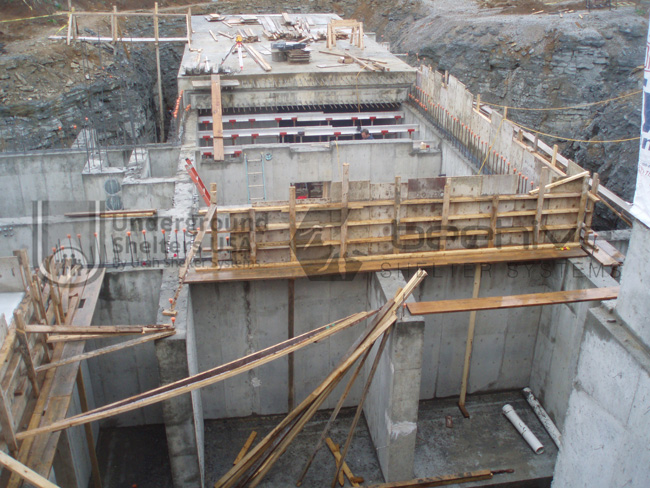
Interior Features:
Ten-foot diameter shelters provide the most economical use of living and storage space for dollars spent.
Ceiling space remains constant in 8, 9 and 10 foot diameter shelters, with a center height of 7 feet.
Storage under hinged bunk seats is provided in every shelter unless otherwise requested.
Battery storage areas can be constructed upon request.
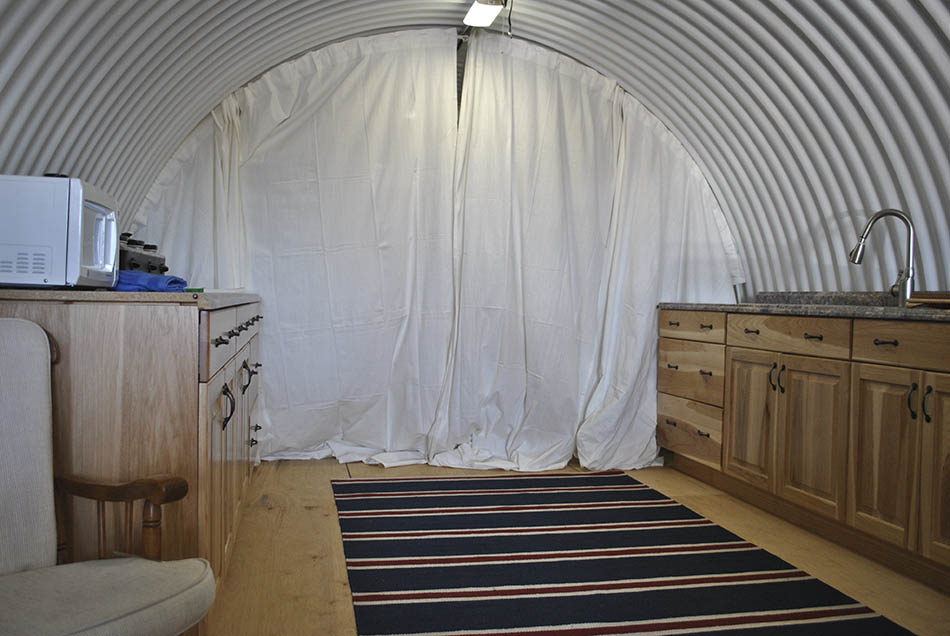
Radio shelves (upon request) fit nicely on the bulkhead, next to the ventilator.
Food and Water: We recommend storing a one-year's supply of food and 55 gallons of water per person. Water can be stored in 30-gallon barrels, under the floor of 10-foot diameter shelters or in 55 gallon barrels on top of the floor in all sizes of shelters. Water can also be stored under the floor in water bladders that form to the curvature of the tank, in any diameter shelter.
Water tanks can be buried outside with a hose attached to provide gravity flow into the shelter. These tanks must be covered with dirt at a depth that is double the diameter of the water tank. Water tanks at or near the surface are vulnerable to 'ground slap' from blast and mischief from intruders.
Large water tanks and water bladders (inside or outside) pose the risk that you may lose your entire supply in the event the containers form a leak. We prefer to use 30 and 50 gallon barrels for water storage; and in our personal shelters, we always store our water inside our shelters.
'All Hazard' Shelters must be protected against the intrusion from chemical/biological war gasses. Gas tight doors and blast valves provide a slightly positive air pressure, as outside air enters the shelter and is filtered though the gas filter. This positive pressure holds un-filtered air from intruding into the shelter. This filtration process is standard with all shelters from Utah Shelter Systems.
People requiring tornado and hurricane shelters, only, may wish to purchase the ventilator without the addition of the gas filter. Call us for pricing on this option.
Some people wish to have an 'air lock' option. An air lock is a preliminary room used for entering and exiting the main shelter without contaminating the shelter room with outside air. See the section marked AIR LOCKS for design information.
Learn about our chemical and biological filters.
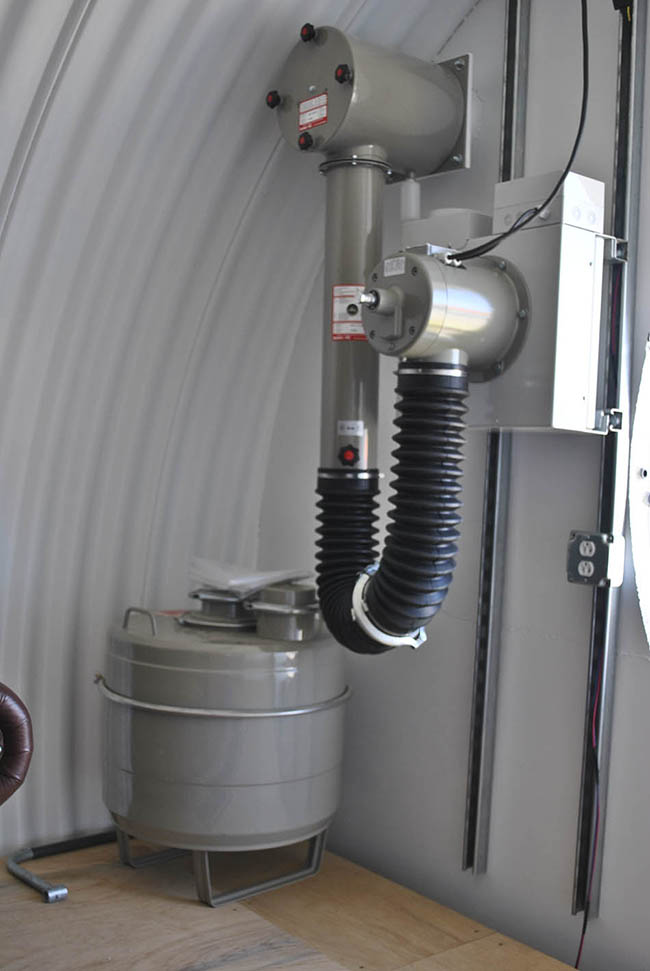
Batteries
We highly recommend using a 12-volt system over the 48-volt system. The 48-volt systems are very expensive and replete with problems. The 12-volt chargers and inverters are reasonably priced and very dependable.
Batteries do not come standard with our shelters. Everyone seems to have their own electrical preferences. All of our shelters, however, come wired for both a 12-volt DC and a 110-volt AC system. We would be happy, however, to direct you to good sources for batteries and supporting equipment. We have used a number of different batteries in our shelter systems. The two we prefer are the 6-volt golf cart batteries and the 6-volt 'gel-cell' batteries. Car batteries should not be used in shelters, as they have a totally different function.

Our first preference is the 6-volt gel-cell battery. Two of these batteries wired for 12 volts are rated at 180 amp hours or 2160-Watts hours. We recommend having no fewer than eight of the 6-volt batteries to run your shelter. In our experience, we have found that gel-cell batteries can be charged many more times with excellent recovery than can deep-cycle lead-acid batteries. They are two to three times more expensive, however they do not outgas and they have a much longer life expectancy. Gel-cell batteries require a special charger. We like the IOTA DLS 55 or DLS 75 charger.
We have prepared our own personal shelters to run on battery power for at least 3 weeks, before needing to recharge. After that period of time, we plan to recharge the batteries with a small generator or other alternate power system. Solar panels are vulnerable to EMP, and may fail if left out during wartime.

Solar Panels
Solar panels may be used to recharge the batteries, but when not in use they should be stored inside the shelter for maximum protection from blast and EMP. They should be placed outside only after all danger of blast has passed. They may be adversely affected by the EMP. If in a remote area, consider putting out a 'sacrificial' panel and purchasing extra solar panels for later. Store these panels wrapped in aluminum foil, for 'EMP' protection, and keep them inside your shelter until use.
In remote areas, we use our 'sacrificial' solar panels to keep a charge on our batteries at all times. We know an EMP would most probably destroy the panels, but it is worth the sacrifice to have charged batteries when we arrive at the site. We usually run one 30-watt panel at a time. We keep several more solar panels inside the steel shelter to protect them from the EMP.
Don't spend your amp hours unwisely. Hand-pump your air system and eat pre-cooked foods. Wear warm clothing and think only, 'basic survival'. Your battery power should be used only for lighting and radio communication.
It should be obvious, how important the battery system is. Take care of them and keep them charged on a regular basis. It would be catastrophic to enter your shelter in an emergency, with uncharged or damaged batteries.
Generators
We prefer diesel generators to gasoline or propane. Diesel fuel stores very well, if a stabilizer is added each year. We never store propane or gasoline in an underground generator room. A small generator can be stored in your shelter room, but must be taken outside to run it.
We recommend the purchase of a diesel generator at (or smaller) than 2kW, for battery charging. Large generators are great for running a house, but the fuel will not be readily available after large-scale emergencies such as full scale EMP or full-scale nuclear war. The exception to the large generator rule is if you need to run a motor in a deep well.
Mechron Power Systems (613-733-3855) sells a 2kW Portable military, brush type diesel Generator. It has very low fuel consumption, running on about 1 pint per hour. Brush type generators are less vulnerable to an EMP.
Energy Management (801-366-4100) has brush type generators available in 8 kW, 10kW and 15 kW sizes. You may wish to purchase an extra voltage regulator, as it will be EMP vulnerable.
Lighting is provided with both an AC and DC wiring system. Miniature 12-volt lights are are placed every 8 feet along a ceiling unistrut. These lights use a standard bayonet base and may be replaced from stock found at Radio Shack. These lights are protected against blast by their installation on a sturdy wire, which hangs a couple of inches below the unistrut. During a disaster, we plan to keep one (and only one) of these miniature lights turned on at all times. As a note, LED lights may be used to replace the standard lights in the shelter. They are, however, expensive and may be vulnerable to the EMP effect. LEDs should be stored in a Faraday cage until after all threat of an EMP has passed.
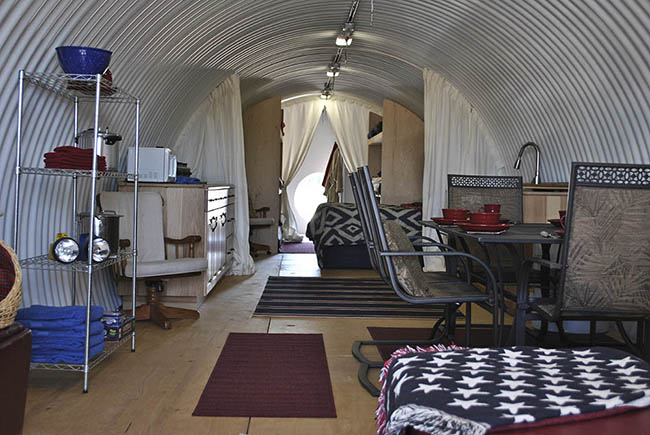
During peacetime, we use the 12-volt fluorescent lighting system that comes with the shelter. We also have access to AC receptacles that have been placed every 8 feet along the ceiling unistrut, and can uses them for plug in type lamps if we desire.
We often speak of the scenario of experiencing a large earthquake in the middle of the night, and in the middle of the winter. At near or below zero temperatures, if unprepared, few people would survive the night. Our shelters would withstand a huge earthquake and all associated after shocks. We have beds, food, water, light, communications, clothing and supplies ready in our shelters at all times. We could just go to our shelters, go to bed, and deal with the earthquake in the morning!
Shelters with 7 to 10 feet of dirt cover, remain at a constant temperature between 45 F. and 65 F. Our shelters installed in the mountains of Utah, in below 0 Fahrenheit weather, never go below 45-degrees Fahrenheit. In the winter we wear lightweight jackets or sweat shirts and feel very comfortable. As occupants enter the shelter, the temperature will rise. Every person radiates as much heat as a 100-watt light bulb. The steel walls of the shelter act as a heat sink, and keep the shelter from becoming too warm. We highly recommend that NO insulation be placed on the walls or ceiling of steel shelters. No outside source of heat is needed. In peacetime, if fuel and power are not an issue, the shelters can be heated with an electric space heater.
Holding tanks and septic tanks are acceptable in areas of low or no blast and areas. The tanks, however, are extremely vulnerable to ground slap from blast, and may crack or rupture during earthquakes. Flying debris from high winds during tornadoes, hurricanes or blast could break the lids of septic tanks, and if they are at or near the surface, or sit over the shelter, the contents of these tanks could be forced back into the shelter.
Flush toilets and showers are very convenient. If the bunker has a well or is near a source of unlimited water, you may wish to consider this option.
In areas of high risk for blast, we prefer (and install) chemical toilets, as these toilets are care free, simple to use, and easy to empty and clean.
Please be advised:
In order to increase waste capacity, use separate toilets for solid waste and urine. Cover solid waste with a disinfectant solution or kitty litter. Solid waste should be stored in barrels in double plastic bags, until it is safe to remove and bury it outside. Urine can be poured into the gray-water drain.
In the event of a nuclear or biological attack, you may not be able to return to your home to live. Bacterial agents may enter your above ground home through broken windows and the furnace ducting system. Sunlight will destroy bacteria that are on the ground, but it cannot reach inside your ducting system to destroy these agents. If your home is damaged or destroyed and you are forced to continue to live in your shelter, construct an old-fashioned 'outhouse' downhill from your shelter.
Look carefully at the risk assessment section. Please feel free to call us with questions (Sharon at 801-380-2932 or Paul at 801-631-7684). We would be happy to evaluate your location and help you with your design options.
Steel shelters installed with 6 to 10 feet of dirt cover do not pose a heating and cooling issue. In the severe temperature variations (-20F to 100F) the interior of the shelters stay within a 20-degree temperature range (45F to 65F). In warmer areas, the air vents may require a deeper and longer horizontal run to cool the intake air before it enters the ventilation system.
We sometimes install a wood burning stove to heat the shelters during cold spells. These stoves cannot be used during threat time of nuclear fallout or war gasses, as the air to the stove is not filtered. We provide gas tight shut off valves for closure during those high threat times.
Outside information is critical for your survival in a disaster. Plan to have several forms of communication. We suggest that you purchase a good short wave radio, CB radio, and if possible, an amateur radio in the 40 to 80 meter band area. CBs are useful at short distances and are 'line of site', only; but they will provide local information, which may be very important. The usefulness of two -meter radios is limited after a nuclear attack, because the EMP will destroy relay stations needed for two-meter transmission and reception, even though the radio itself, may have survived the event. Two meter radios, though much more expensive than CBs, will have the same resulting range. Amateur radios in the 40 to 80 meter range, on the other hand, will continue to function (if protected during the actual EMP event) because relay stations are not needed for their use.
We highly encourage at least one of the people assigned to your shelter, to become a licensed amateur radio operator. Form nets using similar maps, and practice disaster scenarios.

Though protected, radios may not function for a few hours to days because of disturbances in the ionosphere. After two full days, turn on and listen to your radio for short periods of time. It is psychology imperative that you have outside contact. Plan to use your CB or ham radio sparingly, as transmitting on these radios requires a great deal more power than when they are in the 'receiving' mode. If others that you know have shelters, plan to use the same frequencies.
During peacetime we cook in microwave ovens or on electric burners. We never use propane or gas in our shelters for the following two reasons. First, propane is heavier than air and if there is a leak, it could accumulate under the floor where it will pose an ignition problem. Secondly, the burning of fossil fuels, such as propane or gas, produces significant amounts of carbon monoxide.
During emergency operation, we do not use battery or electric power to cook. The preferred method of cooking during that time is via marine alcohol stoves. Unlike propane or gas, when alcohol burns it produces only carbon dioxide and water. Of course, any flame consumes oxygen and requires good ventilation. Alcohol fuel can be purchased at most any hardware or marine store. It is not explosive, but must be carefully stored, as it will act as an accelerant in the event of a fire.
In areas believed to be more than 3 miles from a prime target, various items of furniture can be added to the shelters. All shelters come standard with two sets of double bunks and two sets of single sitting bunks. The bunks add a great deal of comfort and a higher quality of rest. When maximizing occupancy, sleeping should be done in shifts, and each bunk used by a different person for 8 hours during the day. All bunks have hinged tops, providing room for tidy storage of personal items or supplies. The sitting bunks face one another and provide room for a fold-up table to slip underneath, out of site. Tables are convenient and provide a more normal atmosphere to the living space for eating and socializing.
If outside the 3-mile heavy blast range, you may wish to have us add storage shelves, bathroom (including toilet, sink and gray-water drain); and a kitchen (with stainless steel sink, plumbing, 12 volt water pump, Formica countertop, and cabinets).
In areas of high blast potential, keep furniture to a minimum. Use hammocks for sleeping and secure all items to the wall. You may want to substitute two additional lengths of unistrut on the wall, for your standard bunks. The unistrut would then be used to tie-down and secure equipment and supplies.
All shelters come standard with ladders for each of the two entrances. During installation, the 48-inch diameter entrance should be tilted to a 60 degree angle. The step ladder is designed to that angle. The 36 inch diameter exit tunnel is designed for a vertical configuration to facilitate the lowering of supplies by a rope or small crane. The center floor panels are removable in 4 ft. lengths, down the entire length of the shelter. This provides easy access to supplies and keeps the shelter free of clutter.

